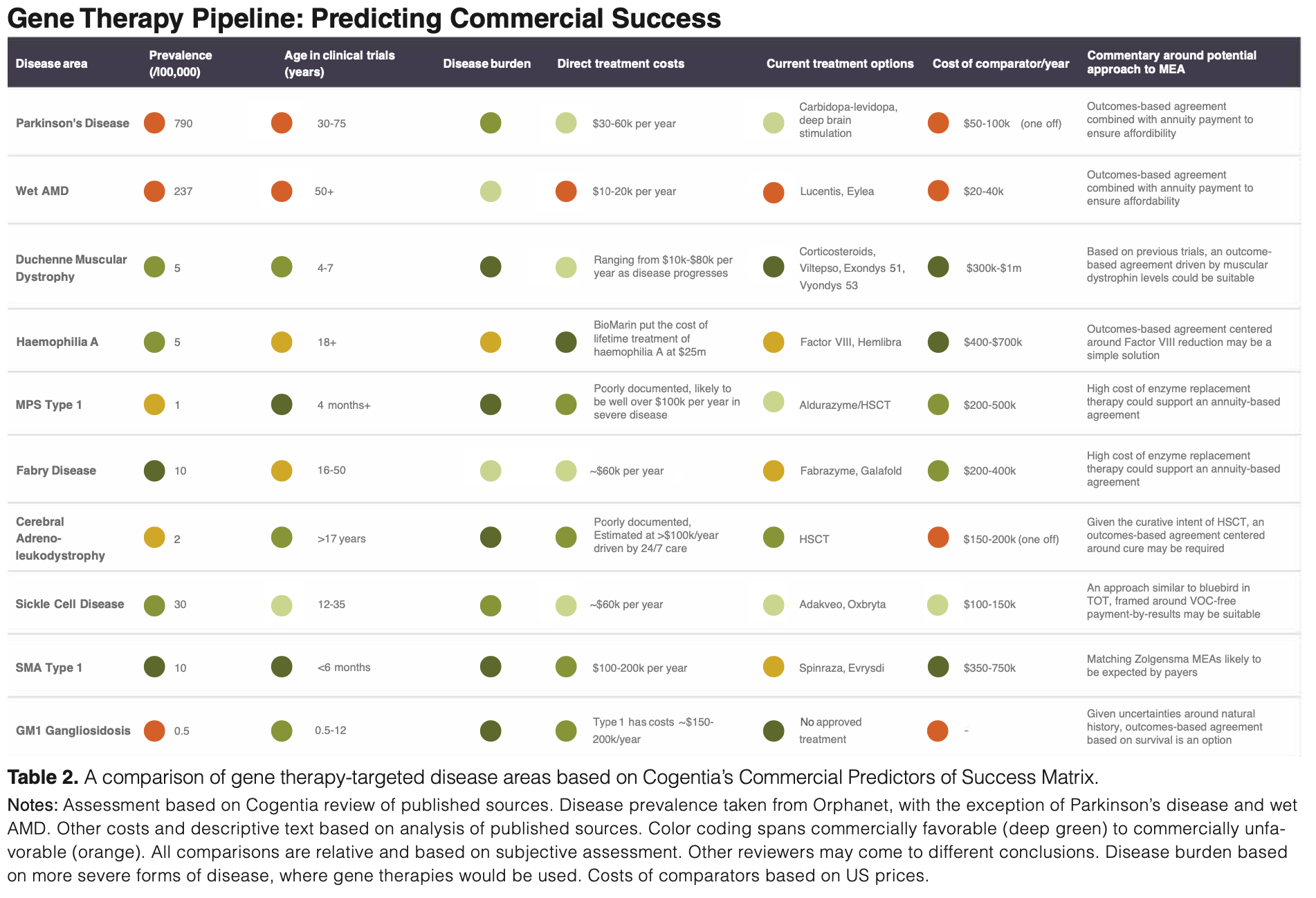By Any Genes Necessary: The Role of MEAs for Gene Therapies
Examining why the cost and administration of these treatments are well suited to managed entry agreements—and which approach to MEA may prove to be the most commercially viable for manufacturers.

With FDA predicting 10 to 20 cell and gene therapy approvals per year by 2025, we are undoubtedly witnessing an exciting time for personalized medicine. However, the combination of a rapid increase in gene therapy pipeline developments, a “one-and-done” dosing regimen, and a price precedent established in the millions of dollars by some of the currently launched gene therapies creates a perfect storm for healthcare systems; “curative treatments for such genetic disorders were unfathomable a decade ago; unfortunately, so are the costs of the cures currently in development,” as CVS Health puts it.1
The high price of gene therapies is based on anticipated long-term benefits—benefits which at launch are often subject to significant uncertainty. This presents a challenge to both affordability and sustainability, a challenge which can be addressed at least somewhat by the use of managed entry agreements (MEAs). MEAs aim to make the high cost of these one-off treatments more palatable for healthcare payers, who might balk if faced with the entire cost upfront. Most importantly, they ensure any uncertainty regarding long-term effects can be addressed while facilitating timely access for patients who are often in desperate need of an effective treatment. Key questions remain with regard to MEAs, including how they can be incorporated into clinical development, and what can be done strategically at the outset by manufacturers to support commercial performance.
In this article, we analyze the sustainability of the gene therapy pipeline, and review the MEA landscape. By selecting 10 disease areas being targeted by gene therapies in development, we consider the levers of commercial success, as well as how appropriate deployment of MEAs may address key challenges. Additionally, by using Cogentia’s matrix of commercial viability, we assess which approach to MEA may prove most suitable for the 10 disease areas, and discuss the importance of considering potential access agreements early in development.
Sustainability challenges
A recent white paper published by CVS Health paints a stark picture; by calculating five-year total cost impacts for a selection of near-term assets in the gene therapy pipeline, the authors calculated a low market impact of $14.85 billion, and a high market impact of $45 billion in the US alone. Concerningly, this was only based on the 11 projects that are closest to market.1 If the market impact of gene therapies that are successful in the clinic approaches anything close to these figures, it is highly unlikely that healthcare systems would be able to cope.
MEAs are increasingly seen as an important solution to address the unique challenge presented by one-and-done treatments like gene therapies. Table 1 below describes the range of MEAs available to manufacturers and payers alike, with examples included for each. Some countries have a preference for simple MEAs such as a dose cap or flat discount rather than more complicated outcomes-based contracts. Take, for instance, the recent NICE approval of Zolgensma. While the “day-one” access scheme and high price might make Zolgensma an obvious candidate for outcomes-based MEAs, NICE and Novartis instead settled on a simple flat discount from list price.2

Of note is that a treatment can be subject to multiple MEA approaches, for instance, an annuity-based, outcomes-based agreement scheme such as that proposed in Germany for Zynteglo. Zynteglo, an ex vivo gene therapy for transfusion dependent β-thalassemia (TDT), provides a good example of an outcomes-based agreement. bluebird bio was hailed in some quarters for its innovative approach to MEAs, leaving 80% of the €1.575 million list price of Zynteglo on the table with its first agreement in Germany, with further payment contingent on transfusion independence.
However, the recent withdrawal of Zynteglo from the German market after a dispute over price illustrates the point that MEAs are not a silver bullet. As Professor Richard Barker, former director general of the Association of the British Pharmaceutical Industry (ABPI) and current CEO of New Medicine Partners, put it in an interview with Cogentia, “Very expensive, one-time cures by gene therapies pose a novel situation for healthcare payers. It will need almost as much creativity to agree [on] reimbursement models as it does to create the therapies in the lab and clinic.”
Assessing commercIal prospects and MEA
The bluebird example demonstrates the importance of planning early from a commercial perspective. There are a number of strategic questions that should be asked early on in development for gene therapies. For instance, if a high price is expected to be sought, how can this be justified? If the cost is likely to be unpalatable upfront, or if significant uncertainty is expected at launch, manufacturers would benefit from considering how to address this, and whether an MEA approach might be appropriate, or even essential.
To explore the sustainability of a number of gene therapy-targeted disease areas, Cogentia has devised a matrix of factors that consider commercial prospects of assets in the pipeline—factors including prevalence, resource use, age of infusion, and potential MEA approaches to address the challenges discussed. We have selected 10 diseases being targeted by gene therapy manufacturers to assess, and in doing so aim to predict elements that may prove to be supportive or challenging in the pursuit of the next commercially successful gene therapies to follow in the footsteps of Zolgensma.
The 10 disease areas to be assessed are selected on the basis of being intentionally diverse, with priority also given to those that are targeted by a number of gene therapy projects in the clinic:
- Parkinson’s disease
- Wet age-related macular degeneration (AMD)
- Duchenne muscular dystrophy (DMD)
- Hemophilia A
- Mucopolysaccharidosis (MPS) type I
- Fabry disease
- Cerebral adrenoleukodystrophy
- Sickle cell disease
- Spinal muscular atrophy (SMA) type I
- GM1 gangliosidosis
The factors analyzed in Cogentia’s commercial matrix (see Table 2 below) are described here:
- Prevalence.The disease should be relatively prevalent in rare disease terms, but not so prevalent that payers balk at a price anywhere above five figures. A prevalence of around 1/10,000 appears optimal (SMA type I allows Zolgensma to command a high price while still treating a steady stream of patients).
- Age of eligibility. The gene therapy should be administered as early in life as possible, with the potential for benefits to accrue over a full lifetime.
- Disease burden.The disease should be severely debilitating, or the gene therapy should be targeted at the most severe form of the disease (for example, MPS or SMA type I).Healthcare resource use. Resource use should be high, with significant cost-savings expected in those who receive a gene therapy.
- Current treatment options. Options should be limited and not considered to be effective, potentially with challenging safety profiles and questions over benefit/risk ratio.
- Cost of comparator. Comparators should be expensive, setting a precedent for high pricing and offering a simple like-for-like cost offset for budget impact estimates (think Zolgensma and Spinraza).
- MEA approach. To address an anticipated high-cost, one-time drug approach, what MEA may be most appropriate? A good MEA should address uncertainty, be implementable/transactable, aim for simplicity, and represent appropriate risk share.
By using a matrix like the one displayed in Table 2 below, we can start to assess the sustainability of the gene therapy pipeline, and consider to what extent MEAs can support a gradual budget impact rather than a huge initial cost upfront. As demonstrated by Zolgensma, SMA type I is clearly well suited to several managed-entry options, including annuity-based payments (resulting in a similar price to competitors/year), and outcomes-based agreements (based on standardized criteria, measurable + validated outcomes). It is clear that different disease areas will require different approaches to MEAs. The cost saving of reduction/independence from factor VIII in hemophilia A is likely to translate neatly into a relatively simple outcomes-based agreement driven by reduction in use of factor VIII replacement. In DMD, the price of comparators and use of muscular dystrophin in previous trials could support either an annuity-based agreement, or an outcomes-based agreement driven by muscular dystrophin levels.
Click to enlarge

Other disease areas are likely to require more innovative thinking. In diseases with poorly established natural history such as GM1 gangliosidosis, an outcomes-based agreement may be premised on a well-established outcome such as survival. In Parkinson’s and wet AMD, the prevalence and lack of obvious cost offsets could lead payers to prefer a long-term outcomes-based agreement, ensuring affordability for the healthcare system. This is another important consideration when planning an MEA; when is the “expiry” date, the date by which any data uncertainty should have been resolved? Is your MEA a simple five-year annuity-based agreement? At what stage will the evidence generation from pivotal trials/real-world evidence (RWE) be sufficiently mature to convince payers of value-for-money?
The path forward
In the context of the boom in gene therapy development, it remains critical for manufacturers and payers to consider sustainability. The gene therapy pipeline provides a unique challenge to payers and pharma alike. These treatments are likely to be high-cost, one-time infusions, and if the price were paid on a one-time basis, the budget impact would come in one massive blow rather than being spread out over time. In combination with the significant data uncertainties likely to exist at launch, this makes gene therapies a prime candidate for MEAs.
Cogentia’s analysis of a range of factors contributing to the sustainability of gene therapy-targeted disease areas presents significant variability in these conditions. Some disease areas such as haemophilia A and DMD appear to lend themselves particularly well to relatively simple cost offset-driven MEAs. In diseases with poorly established natural history, as with the example of GM1 gangliosidosis explored earlier, manufacturers may be pushed toward more well-established outcomes such as survival rather than biomarker/natural history-driven outcomes.
In conclusion, the high-cost and one-time nature of gene therapies appears especially well suited to MEAs. It will be important for manufacturers to consider early on in development how a MEA can support commercialization, how payers perceive several potential approaches to MEA, and what outcomes and measures should form the basis of said agreement.
References
- White Paper: Gene Therapy | CVS Health Payor Solutions [Internet]. [cited Feb. 3, 2021]. Available from: https://payorsolutions.cvshealth.com/insights/gene-therapy-keeping-costs-from-negating-its-unprecedented-
potential - Project documents | Onasemnogene abeparvovec for treating spinal muscular atrophy type 1 [ID1473] | Guidance | NICE [Internet]. [cited March 13, 2021]. Available from: https://www.nice.org.uk/guidance/indevelopment/gid-hst10026/documents
Mark Orchard, Senior Analyst, Cogentia, email: mark.orchard@cogentia.co.uk

Trump: 'Major Tariff' on Pharmaceuticals Coming Soon
Published: April 9th 2025 | Updated: April 9th 2025“We’re going to tariff our pharmaceuticals, and once we do that, they are going to come rushing back into our country," President Donald J. Trump said during a Tuesday night dinner in Washington.